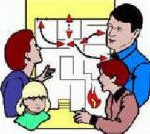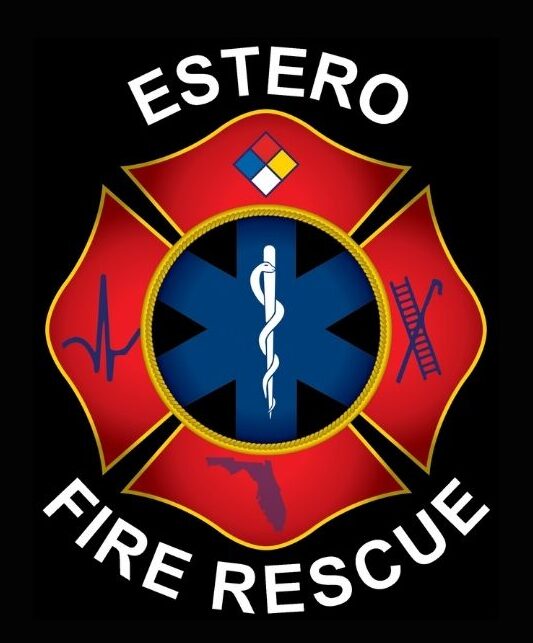
The attack on the World Trade Center created a catastrophic collapse of both towers. While this tragedy will be reviewed and evaluated for a long time to come, it has prompted Americans to rethink fire safety.
A fire in a high-rise residential building can be confined to the apartment where it starts. However; smoke and heat can travel throughout the building, especially upward.
High-rise residential buildings are constructed to be fireproof. However, most of what is inside the buildings, including your furnishings and belongings, can burn and produce a tremendous amount of heat and smoke.
Fire Safety begins at home; this is even more true for those who live in multi-story, multi-family mid to high-rise apartment buildings. Every family should know the basics of how to prevent, report and escape fires at home.
Estero Fire Rescue has prepared this information to help the whole family learn what steps to take to ensure that everyone’s home is fire safe. If we work together, you and your family can be safe from the hazards of fire.
 Human behavior has been recognized as a factor in the loss of life in fires for many years. Studies of human behavior during emergencies have assisted code developers and public educators to identify factors that affect occupant survival during a fire emergency.
Human behavior has been recognized as a factor in the loss of life in fires for many years. Studies of human behavior during emergencies have assisted code developers and public educators to identify factors that affect occupant survival during a fire emergency.
Human behavior studies indicate that the reaction of people to an emergency condition is related to a number of factors, including a person’s assumed role, experience, education and personality, as well as the emergency’s perceived threat and the actions of others sharing the experience.
Visitors in a facility will typically be more passive and look for guidance from occupants.
Individuals who have participated in drills and received training in emergency response react faster and with better decision making than those without training.
The personality of an individual has an impact on how he or she will react in an emergency. Some individuals may attempt to fight the fire; others will attempt to escape immediately.
This is why developing and practicing escape plans is so important for your survival.
Ways to Keep your Residence Safe:
 Never keep rubbish in the hallway. Make sure it is stored properly and collected regularly.
Never keep rubbish in the hallway. Make sure it is stored properly and collected regularly.- Don’t put items in the trash chute that are too big and may get stuck. Things caught in the chute easily can turn a fire in the lower floors into a fire on higher floors.
- Be careful not to overload electrical circuits. Short circuits are the cause of many fires.
- Cook with care. Keep a tight fitting lid near by that can be used to smother stove fires.
- Never smoke in bed and make sure that there are no smoldering butts when you empty ashtrays.
- Test smoke alarms monthly and replace the batteries twice a year.
- Make sure that your apartment door is tight-fitting, self-closing type of door in compliance with the fire code.
- Inspect your exit stair doors. They must be self-closing, snap shut and unlock from both sides. If they don’t meet this standard, report it to the superintendent or the Fire Department.
If The Fire is in Your Apartment:
- Get everyone out. Stay low as you go out. Close but don’t lock all doors in the apartment as you leave.
- Alert others on the floor by knocking on doors. Activate the fire alarm if there is one.
- Go down the nearest STAIRWAY, holding the railing.
- Never use the elevator during a fire.
- Above all ~ Stay Calm
If the Fire is NOT in Your Apartment:
- Stay inside rather than entering smoke-filled hallways, especially if the fire is on a floor below your apartment.
- Keep your door closed.
- Seal the door with duct tape or wet sheets and towels. Seal ventilators and any other openings where smoke may enter.
- Turn off air conditioners.
- Unless flames or smoke are coming from below, open your windows a few inches at the top or bottom. Don’t break the windows; they may need to be closed later.
- Call the Fire Department (9-1-1) with your apartment number and a description of the conditions in your apartment. Firefighters will be directed to your location.
- Wait at a window and signal for help with a flashlight or by waving a sheet
- Once your are out, STAY OUT. Don’t go back inside for any reason.
Planning Ahead Can Save Your Life:
Things to know:
- The layout of your floor.
- The location of all stair exits from your floor.
- The number of doors between your apartment and the exit stairs. This is essential knowledge to find the exit in the dark.
- Where your apartment key is located. Take the key with you if you are forced to evacuate.
- The location of fire alarm pull stations
Things to Do:
- Keep flashlights ready and in a handy place.
- Install and maintain smoke alarms. Owners of high-rise buildings are required by law to install one alarm in each apartment, but maintenance is up to you.
- Report fire hazards to your building superintendent. Blocked exits, piled trash, missing exit lights and open fire doors are violations of the law. If your superintendent doesn’t correct them call the Fire Department (239) 390-8000, and report the condition. Your life may depend on getting the violation corrected.
 Plan ~ Then Practice
Have you practiced your plan recently? You should, because changes that happen within your home could affect how well the plan works. By practicing four times every year—once every time the season changes—you can make any changes that will ensure you and your family’s safety.
Plan ~ Then Practice
Have you practiced your plan recently? You should, because changes that happen within your home could affect how well the plan works. By practicing four times every year—once every time the season changes—you can make any changes that will ensure you and your family’s safety.
Have you practiced your plan in the dark? You should, because it’s important to simulate as much as possible what a real fire situation would be like. Most fires happen at night, and the smoke from a fire can make it impossible to see anything. By practicing in the dark, you can see how well your plan works when you have to “feel” your way along your escape route.
Have you tested whether everyone is awakened by the smoke alarms? If someone doesn’t wake up, you may need to install a new alarm over their bed. When you practice your plan, hold a fire “drill” at night, when people are sleeping. Some people especially children sleep so soundly even a smoke alarm won’t wake them.
In a fire, the smoke will rise towards the ceiling, so crawling on your hands and knees will give you practice with staying down where it’s easier to see and breathe.
Have you kept your hallways and stairs free of clutter? While boxes, book, bicycles, carriages, plants and toys may seem harmless in the daylight, they can become dangerous obstacles during a dark, smoky fire. They may trap you from getting out and a firefighter who’s trying to get in.
Did you remember to close doors behind you after you’ve gone through? Open doors allow for free oxygen flow, which can help a fire spread to other parts of your home. Closing doors behind you helps to contain any fire.
If you have self-closing fire doors (many apartment buildings do), did you make sure that the doors were able to close behind you? Often obstacles such as thick doormats will keep doors open, allowing oxygen to fan the fire.
Does your family sleep with their doors closed? If so, you may want to install a smoke alarm in each of these rooms. Consider installing inter-connected smoke alarms. This can give everyone in your home an early warning, because all inter-connected smoke alarms sound when one goes off.
Don’t PANIC. Practicing your evacuation plan will help you to remain calm and in control.
- Every 18 seconds fire occurs in a U.S. Residence.
- Every 34 minutes a civilian is injured by fire.
- Adding residential sprinklers to a home equipped with a smoke alarm increases your chances of surviving a fire from 63% to 82%.
- Young children, older adults, and physically and mentally challenged people face the highest risk of injury or death in residential fires.
- Too often, people fail to respond to the sound of a smoke alarm, assuming it’s a false alarm. Rather than exiting the building, they search to confirm the existence of a fire, wasting the few precious minutes they may have to escape.
Is high-rise building evacuation different from other buildings?

The multiple floors of a high-rise building create the cumulative effect of requiring great numbers of persons to travel great vertical distances on stairs in order to evacuate the building. The physical demands made on occupants often exceed the capabilities of many.
The fire and life safety systems installed in high-rise buildings today, including automatic fire sprinkler protection, are designed to control a fire and therefore lessen the need to evacuate all occupants. In a typical scenario, the occupants of the fire floor and the floors immediately above and below it should immediately use the exit stairs to descend to a floor level that is at least several floors below the fire floor, and await further instructions from safety officials.
What are the key elements of emergency preparedness?
Early warning (typically through an alarm or voice communication system), adequate means of egress (exit routes) and occupant familiarity with the plan through knowledge and practice.
If stair travel is potentially dangerous, are there alternative?
The construction, Fire protection and life safety systems installed in high-rise buildings, including automatic sprinkler protection, are designed to control fire so as to lessen the need to evacuate all occupants to the street level. The occupants of the fire floor and floors immediately above and below it should immediately use the exit stairs to descend to a floor level that is at least a few floors below the fire floor. The occupants can then reenter the occupied space on those safe floors to await further instructions.
If exiting down stairs takes so long, am I better off going up to the roof and waiting to be rescued there?
NO! Many of us have seen dramatic video of helicopters picking up occupants from the roof of a burning building. This is extraordinary dangerous procedure for the occupants, the pilots and firefighters who may be in the building.
First, a helicopter may not come to rescue you, thus ascending to the roof instead of descending to grade may have wasted valuable time. This is not a standard procedure in the U.S., or in most foreign countries.
In severe fires, the large thermal currents, generated by the heat from the fire, can cause the helicopter to be buffeted up or down, making it hard to control. The resulting down thrust from the helicopter rotor can force smoke and super heated air on top of fire suppression personnel. Most building designs incorporate numerous features that direct occupants to the street or grade level for evacuation purposes.
Can I use the elevator?
 NO! It is never appropriate to use the elevator during a fire or similar building emergency, even in a two-story building. When a fire occurs, elevators are designed to be recalled to designated floor, normally the lobby. In unusual circumstances, an elevator malfunction may cause the elevator to travel to the fire floor itself, thus exposing occupants to the fire. Elevator shafts may also allow some smoke to enter the shaft and migrate toward the roof of the building. Any occupants of the elevator would be exposed to that smoke.
NO! It is never appropriate to use the elevator during a fire or similar building emergency, even in a two-story building. When a fire occurs, elevators are designed to be recalled to designated floor, normally the lobby. In unusual circumstances, an elevator malfunction may cause the elevator to travel to the fire floor itself, thus exposing occupants to the fire. Elevator shafts may also allow some smoke to enter the shaft and migrate toward the roof of the building. Any occupants of the elevator would be exposed to that smoke.
What if the emergency is not a fire, how should I react?
As with any situation in our daily lives, YOU are ultimately in control of your fate to a great degree. Thus, you are largely responsible for your own personal safety based upon circumstances. Detailed procedures, verbal instructions and even past experience may not be adequate to help you deal with extraordinary events.
RED, the universal color for danger can be used to help you in such circumstances.
React: Take any indication of smoke, fire or other potentially threatening situation seriously. Activation of building fire alarms, smell of smoke, visual indication of flames, warning from other occupants, arrival of the fire department are some attributes that may signal an imminently dangerous situation.
Evaluate: You must judge the level of threat. This includes confirming evidence or presence of smoke or fire; judging the conditions in your immediate area; self-judgment of your physical ability to relocate or evacuate; evaluation of the needs and abilities of others who may need assistance; consider additional information being received.
Decide: There are only two, but difficult choices:
1. Follow your plan and immediately leave the building. OR
2. Follow your plan and stay where you are, or descend to the designated level below the fire floor and be prepared to take protective/defensive action. In this case, anticipated action may include alerting the fire department (9-1-1)of your location, seal doors, windows and vents that lead into your space. Do not break out the windows. Be prepared to wait for a considerable time period (at least one hour) if you contemplate rescue by the fire department.
This process is iterative. It is not only done at the first hint of a dangerous situation, it is a process that the individual must manage and needs to be repeated until the danger has passed or, if total building evacuation is in order, when that action is completed.

